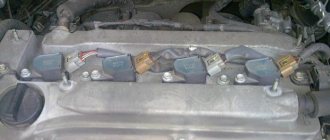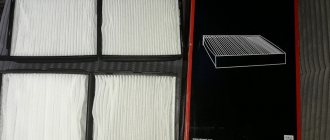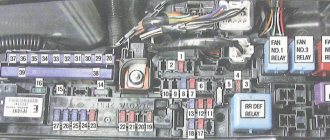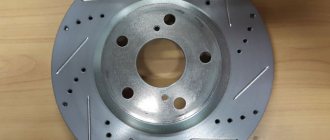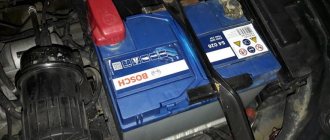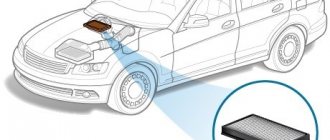Toyota Camry is a medium business class car produced since 1982. In Russia, this four-door sedan is considered the most popular in its class. The Camry's closest competitors are the Mazda 6, Ford Mondeo, Volkswagen Passat and Nissan Teana. The car has become known in the domestic market since the early 2000s, when the fifth generation Camry (2001-2006) was popular.
Since 2021, the eighth generation of the four-door business sedan, which has been produced in St. Petersburg since 2021, is relevant. Our car is available with 2.5 (181 hp) and 3.5 liter (249 hp) engines, which work with an eight-speed automatic transmission.
Features of the power steering mechanism
In the car brand in question - Camry - the element traditionally consists of several parts:
- A cylindrical hydraulic device through which the pressure option is converted.
- A pump that promotes high-quality circulation of working fluid, as well as normalization of pressure indicators.
- Power steering oil for Toyota Camry 30 and other cars, facilitating the transfer of resistance to the hydraulic cylinder, as well as the lubrication of friction pairs.
- The steering gearbox + distributor contributes to the air flow that directs the oil to the desired cavity and back. This mechanism must have a certain operating order to ensure quality.
The steering wheel in almost every car is equipped with power steering, thanks to which driving the car is comfortable and simple.
The oil fluid needs to be replaced periodically, the frequency of this process depends on the condition of the wheel control.
That is, if the steering wheel turns poorly and noise occurs when turning, it is necessary to add oil or replace it.
Which liquid to choose
With the choice of power steering fluid for Toyota Camry 40, in contrast to the selection of engine oil, the question is simpler. The manufacturer recommends pouring Dextron II or III (yellow oil is poured into the power steering Camry 40 from the factory). Most Japanese sedan owners use the original Toyota Automatic Transmission and Power Steering Fluid DEXRON III (number: 08886-80506 or 08886-81250). It is also possible to consider Toyota PSF-EH (08886-01206), Toyota PSF in a 4-liter canister (08886-01005) and Toyota PSF NEW-W fluid (08886-01115) if the car is used in cold climates.
In the absence of original oils, analogues from other manufacturers may be used:
Features and stages of replacement work
Probably, many owners and car enthusiasts are aware that all technical devices must undergo maintenance, which involves monitoring the fluid level in the power steering. If there is the slightest malfunction, this is the first thing you should pay attention to. Maintenance stages:
- Place the car on a jack or pit for inspection and hang out the wheels located in the front of the car - the steering wheels.
- Carry out work to disconnect the return hose and drain the fluid from the power steering tank.
- Remove and wash the tank body.
- Installing the structure without attaching a hose and starting the engine by twisting the steering wheel at idle.
- Completely drain the fluid from the entire system and shut off the engine.
- Fill the tank with the most suitable product for the job and restart the engine with an increase in frequency.
- It is necessary to turn off the engine and repeat the last steps several times until the air is completely eliminated.
- The return hose must be connected to the tank, and it is worth adding fluid to the required level. After this, the engine is fully started at 1000 rpm.
- It is worth checking the degree of foaming of the product; if this occurs, you need to continue pumping work. After plugging the unit, it is necessary to check the fluid level in relation to the amplifier.
- You need to set the level that is most suitable, and after a certain period of time has passed, it is important to check it again.
Liquid
for power steering in
Toyota Camry
In this article we will discuss in more detail devices that reduce the forces on the steering wheel of a car. We will take a closer look at the power steering, which are designed to be installed on Toyota Camry
.
So, this article contains answers to these fairly common questions:
- What is a hydraulic booster?
- What is the operating principle of power steering?
- Camry
vehicle ; - How to properly replace fluid
on a Toyota
Camry
?
Video guide
Power steering fluid in Toyota Camry
In this article we will discuss in more detail devices that reduce the effort on the steering wheel of a car. We will take a closer look at the power steering, which is designed for installation on a Toyota Camry.
So, this article contains answers to these fairly common questions:
- What is a power amplifier?
- What is the operating principle of power steering?
- Power steering design for Toyota Camry;
- How to properly replace hydraulic fluid on a Toyota Camry?
Basic information about power steering
Power steering or, as it is abbreviated as power steering, is a hydraulic system of a vehicle, part of the steering mechanism, which is designed to facilitate control of the direction of movement of the vehicle while maintaining the necessary feedback, as well as ensuring stability of operation and unambiguity of the specified trajectory. Replacing power steering fluid in a Toyota Camry 3.5 Toyota Camry v 40. In addition, the power steering is designed in such a way that if it fails, the steering will function, but in this case the steering wheel will turn a little harder. Power steering is one of the most important steering components of any vehicle. In the absence of power steering on large trucks, not all drivers would be able to turn the steering wheel, in which case power steering is required.
Almost all modern vehicles are equipped with power steering. The main purpose of power steering is to create lateral forces when turning the steering wheel due to the presence of an electric drive.
How much to pour
For a normal replacement, 1 liter is enough if the same liquid is poured as is currently in the system. Otherwise, a complete replacement is necessary by displacement, in almost the same way as changing the oil in a Toyota Camry 40 automatic transmission.
The volume of fluid in the system is 1.3-1.4 liters, so that difference (300-400 grams) can cause the new oil to darken after the first trip. To avoid having to change the fluid again in the near future, it is recommended to turn the steering wheel left and right as far as it will go with the engine off, this way the remaining old fluid will come out of the steering rack and the entire system.
Replacing power steering fluid in Toyota Camry 40
Changing power steering
Toyota Camry
40
without disassembling the system with the engine running using a set.
Now let's look at the main advantages and disadvantages of power steering on Toyota Camry
.
So, the main advantages of a power steering for a Toyota Camry include:
- Reducing the number of steering revolutions;
- Reducing the effort when turning the steering wheel.
The main disadvantages of power steering for Toyota Camry
relate:
- High cost;
- Difficulty in establishing;
- Significant changes to the steering system of the vehicle;
- Needs regular maintenance.
Which liquid to choose
With the choice of power steering fluid for Toyota Camry 40, in contrast to the selection of engine oil, the question is simpler. The manufacturer recommends pouring Dextron II or III (yellow oil is poured into the power steering Camry 40 from the factory). Most Japanese sedan owners use the original Toyota Automatic Transmission and Power Steering Fluid DEXRON III (number: 08886-80506 or 08886-81250). It is also possible to consider Toyota PSF-EH (08886-01206), Toyota PSF in a 4-liter canister (08886-01005) and Toyota PSF NEW-W fluid (08886-01115) if the car is used in cold climates.
In the absence of original oils, analogues from other manufacturers may be used:
| Brand | Oil brand |
| Petro-Canada | DuraDrive MV Synthetic ATF |
| Total | Fluide XLD FE |
| Idemitsu | ZEPRO PSF (16470005) |
| Castrol | Transmax Dex III Multivehicle |
| RAVENOL | Hydraulik PSF Fluid (Toyota PSF-EH approval) |
| GT-OIL | ATF Type III |
| Takumi | ATF D-3 |
Changing the power steering oil
In some cases, after changing the oil, car owners notice that the car has become much softer to drive. Although it is not difficult to do this even at home, those who will engage in this process for the first time will have to get creative.
The first thing that inexperienced drivers may not know is that the car must be warmed up before changing the oil. Ideally, drive it for a few minutes. A short trip to the store can be used. After this, you need to remove the reservoir in which the coolant is stored. Below it is located the oil tank for the power steering. Before removing it, it is necessary to pump out the used oil from it.
To do this, it is convenient to use a regular syringe and a dropper tube, which fits perfectly onto it. The process is quite long and painstaking, so it is best to cover everything around with old newspapers or rags so as not to get splashed with oil.
The empty tank must be removed using a ten key. They unscrew the three mounting bolts.
You also need to unscrew the clamp on the return hose located on top and remove this hose, if possible extending it with some suitable tube and also drain the oil.
All that remains is to close the hole in the tube from which the return flowed. The easiest way to do this is with thick polyethylene and an elastic band for money. After this, you can fill in new oil, paying attention to the fact that the level should be slightly higher than o.
After these manipulations have been carried out, you can start the engine for a few seconds. The main thing is to make sure that the drain container and rag do not come into contact with the engine or belt.
It is prohibited to turn the steering wheel when changing the oil!!!
At this moment, the oil will pour into the container that was prepared in advance. You need to make sure that the fluid does not completely drain out of the power steering. If desired, you can continue to add oil. This is, of course, a less economical option, but the replacement will happen much faster. In the end, the price of oil is not so high as to save on your own pleasant driving sensations, and even more so on further expensive repairs of the power steering itself or its pump, which also often fails.
Reassembly of power steering for Camry 40
So, gradually starting and stopping the engine, we wait until new oil begins to flow into the container, which is easy to distinguish by its shade. After this, you need to turn off the engine and begin assembly.
There is little left to do - put the “return” hose on the hydraulic booster and secure it with a clamp, and then screw it back into place. Then, also install the coolant tank.
When everything is set to its original position, do not forget about the need to add oil until about. All that remains is to drive for two or three kilometers, turning the steering wheel as sharply as possible when turning, and then monitor the oil level, adding it to the tank if necessary.
Changing power steering oil is a rather tedious task, but if you do everything correctly, all procedures will take no more than half an hour. You can buy power steering oil at any auto store. It will cost much less than going to a car service center and ordering this work from auto mechanics. In 80% of cases, this solves all problems associated with power steering malfunctions on the Toyota Camry 40.
When to change
Over time, the liquid wears out, and after several years of operation it loses not only its original color, but also its lubricating properties, as metal products from friction and wear accumulate in it, and moisture also accumulates.
Sediment and color of power steering oil after 86,000 km in a Camry 40 body
This problem especially concerns owners of their “new” used cars, because whether the previous owner changed the fluid or not may turn out to be a mystery. In this case, we recommend checking its condition and determining the need for replacement by analyzing external factors: if the oil in the power steering reservoir emits a burning smell and has a dark brown color, it should be replaced as soon as possible.
In the future, an inspection must be carried out every 10,000 km, and a complete replacement must be carried out at 40,000 km.

